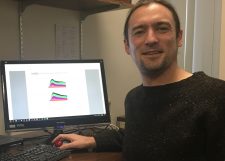Study Advances Predictions of Air Pollution from Oil Slick Evaporation
– JANUARY 17, 2017
Scientists ran model simulations for oil evaporation based on composition measurements of fresh Macondo crude oil and weathered surface oil from Deepwater Horizon slicks. The authors classified hydrocarbons with 10–30 carbons (which make up ~70% of total oil mass) by degree of branching, number of cyclic rings, aromaticity, and molecular weight. The simulations indicated that following the spill, subsurface and surface transport pathways created slicks with a range of evaporative ages. Light hydrocarbon fractions were dominate in the first 30 hours after the spill and longer-chain hydrocarbons were dominate after that. The modeling results suggest that a constant evaporation flux of volatile material during spills can lead to sustained ozone production. The authors published their findings in Journal of Geophysical Research: Oceans: Modeling comprehensive chemical composition of weathered oil following a marine spill to predict ozone and potential secondary aerosol formation and constrain transport pathways.
The Deepwater Horizon spill released oil that persisted on the water surface and in the water column; however, the spill also released some oil components into the atmosphere. The oxidation of volatilized light hydrocarbons, which leads to the formation of secondary organic aerosols (EPA-regulated pollutants), broadened the spill’s impact area and time scale. These conditions highlighted the need for predicting and measuring atmospheric effects and to assess human health impacts.
“Our evaporation model is the most detailed treatment of oil evaporation so far and aids greatly in predicting air pollution from an oil spill,” said study author Greg Drozd. “Novel state-of-the art analysis using gas chromatography with vacuum-ultra-violet-ionization mass spectrometry allowed us to show that some of the released oil traveled up to 100 km away from the Deepwater Horizon rig prior to reaching the ocean surface, showing that an oil spill can lead to air pollution far from the spill site.”
Drozd explained that their analysis and modeling indicated a significant amount of organic aerosol could form from the released oil, which NOAA aircraft measurements taken during the spill confirmed. Wind-tunnel experiments verified their model’s ability to accurately represent the changes in oil composition that occurred during evaporation.
The authors said that initial comprehensive composition can assist researchers and responders to predict potential pollutant formation and the sensitivity of atmospheric emissions to the type of release (deep-sea versus surface spill). Information on oil composition and prediction of time-resolved weathering effects can inform response decisions on the window of opportunity for response measures (burning, dispersant application), dispersant formulation, and predicting flocculation events.
Data for this study are archived at the Gulf of Mexico Research Initiative Information and Data Cooperative (GRIIDC) at doi:10.7266/N7K64G1H.
The study’s authors are Greg T. Drozd, David R. Worton, Christoph Aeppli, Christopher M. Reddy, Haofei Zhang, Evan Variano, and Allen H. Goldstein.
************
This research was made possible in part by a grant from the Gulf of Mexico Research Initiative (GoMRI) to the Gulf of Mexico Integrated Spill Response Consortium (GISR) consortium. Other funding sources included the National Science Foundation OCE-1333148.
The Gulf of Mexico Research Initiative (GoMRI) is a 10-year independent research program established to study the effect, and the potential associated impact, of hydrocarbon releases on the environment and public health, as well as to develop improved spill mitigation, oil detection, characterization and remediation technologies. An independent and academic 20-member Research Board makes the funding and research direction decisions to ensure the intellectual quality, effectiveness and academic independence of the GoMRI research. All research data, findings and publications will be made publicly available. The program was established through a $500 million financial commitment from BP. For more information, visit https://gulfresearchinitiative.org/.
© Copyright 2010-2017 Gulf of Mexico Research Initiative (GoMRI) – All Rights Reserved. Redistribution is encouraged with acknowledgement to the Gulf of Mexico Research Initiative (GoMRI). Please credit images and/or videos as done in each article. Questions? Contact web-content editor Nilde “Maggie” Dannreuther, Northern Gulf Institute, Mississippi State University (maggied@ngi.msstate.edu).






